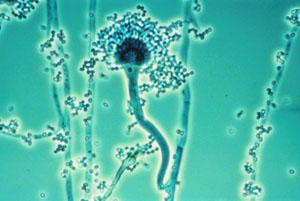
Image of Aspergillus conidiophore and conidia
Overview
Fungi interact with humans, animals, and plants in a variety of ways. Some of these interactions can be beneficial; for example, both penicillin and bread use ingredients made from fungi. However, certain types of fungi can be harmful to health. Like bacteria and viruses, some fungi can act as pathogens. Human fungal diseases can occur due to infection or fungal toxins.
Why are fungal diseases a public health issue?
Mycotic (fungal) infections pose an increasing threat to public health for several reasons. The scientific and medical staff of the Mycotic Diseases Branch is involved with prevention and control among three broad categories of fungal infections:
- Opportunistic infections such as cryptococcosis [PDF - 2 pages] and aspergillosis are becoming increasingly problematic as the number of people with weakened immune systems rises – this includes cancer patients, transplant recipients, and people with HIV/AIDS.
- Hospital-associated infections such as candidemia are a leading cause of bloodstream infections in the United States. Advancements and changes in healthcare practices can provide opportunities for new and drug-resistant fungi to emerge in hospital settings.
- Community-acquired infections such as coccidioidomycosis (Valley Fever), blastomycosis, and histoplasmosis, are caused by fungi that are abundant in the environment. These types of fungi live in the soil, on plants, or in compost heaps, and are endemic (native and common) throughout much of the U.S. Climate change may be affecting these fungi, as even small changes in temperature or moisture can affect their growth.
What is CDC doing to combat fungal diseases?
The Mycotic Diseases Branch responds to the public heath burden of fungal disease [PDF - 2 pages] through a variety of domestic and international activities.
- Responding to outbreaks with epidemiologic investigations
- Monitoring long-term trends in fungal diseases through surveillance
- Developing, evaluating, and promoting cost-effective prevention guidelines and intervention strategies
- Conducting laboratory activities that are vital to outbreak investigations and surveillance studies
- Equipping laboratories in developing countries to perform diagnostic tests
Additional Information
Contact Us:
- Centers for Disease Control and Prevention
1600 Clifton Rd
Atlanta, GA 30333 - 800-CDC-INFO
(800-232-4636)
TTY: (888) 232-6348 - New Hours of Operation
8am-8pm ET/Monday-Friday
Closed Holidays - cdcinfo@cdc.gov


